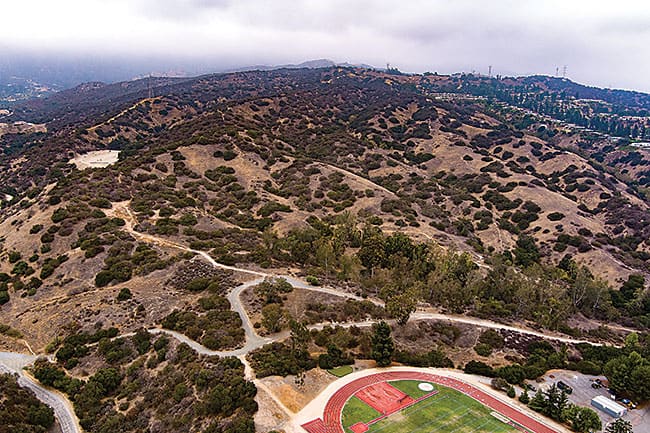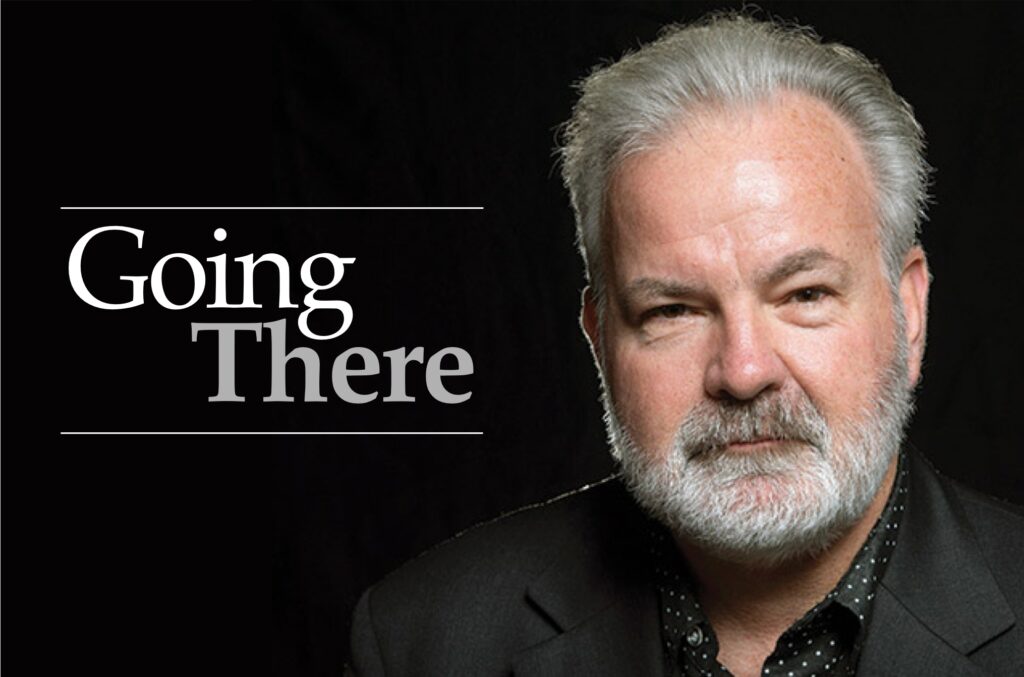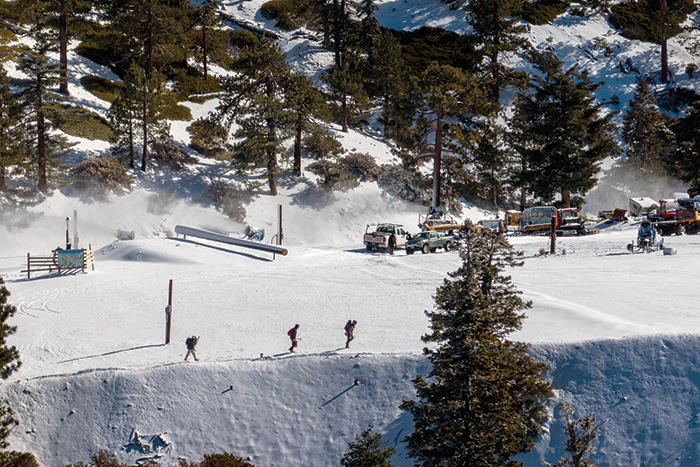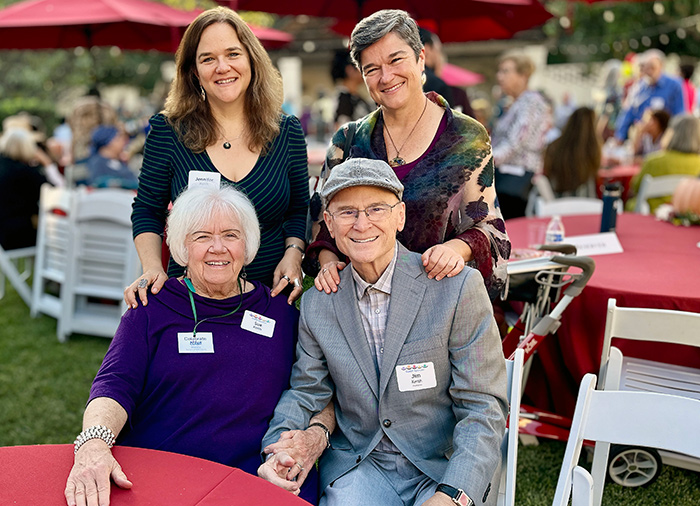Local conservancy works to acquire Clara Oaks

by Steven Felschundneff | steven@claremont-courier.com
Claremont has a long tradition of preserving the hillsides above the city, and one environmental advocacy group would like to add the proposed Clara Oaks development land to the list.
For three years the Claremont Wildlands Conservancy has run a quiet campaign to acquire Clara Oaks, two parcels totaling 102 acres, in the city’s northwest corner where 40 or more luxury homes have been proposed. Recently the group has been more vocal about their effort, in part because the time has come to actually start raising money.
It’s a time honored scenario, with one entity wishing to build homes in a natural area while another is fighting to keep the land wild. Only this time the current owner and developer, Clara Oaks Estate, LLC, represented by Randy Lim, is on board with the idea to preserve the land as long as the conservancy can raise the money in time.
But the clock is ticking. The developer has begun the application process with the city, including a public scoping meeting in June. It’s still in the very early phases so the conservancy has at least a year to raise the money.
“The owner’s top priority is to sell the parcel, through us, to the city for the park. He is going through the entitlement process for development as a back-up measure in case we fail to raise the necessary funds,” chair of the committee working to save Clara Oaks Lissa Petersen said.
If the campaign succeeds, Claremont Wildlands Conservancy in conjunction with the Trust for Public Land will facilitate the sale of the land to the city of Claremont and the two parcels would then be integrated into the existing Claremont Hills Wilderness Park.
“The developer has been working on this for a very long time. We started meeting with him to negotiate what we could get for the Wilderness Park, assuming that he was going to develop, which he has the right to do. We were trying to get as much as possible for the park, a trail and as many acres as possible donated,” Ms. Petersen said. “So when Randy Lim decided to sell the property, his realtor called us in May of 2018 and said ‘do you want to buy it?’ We of course said yes.”
Another possible reason for the developer’s cooperation is the lengthy, and expensive, process to get city approval for a development. Mr. Lim has “a lot of irons in the fire and decided to get rid of this piece,” Ms. Petersen said.
“The proposed project will require the approval of a conditional use permit, a tentative tract map, a zone change, a specific plan, and a corresponding general plan amendment. It will also require the preparation and certification of an environmental impact report (EIR),” according to the project description from the city’s planning department.
Under the Hillside Residential Overlay the developer is allowed to build homes in a “cluster” of about 20 acres of mostly gently sloping land immediately northeast of The Webb Schools.
The land’s value is $7.2 million according to an appraisal facilitated through the Trust for Public Land, which Ms. Petersen characterized as “a heavy lift.” Still, there is grant money available and a shared goal among conservancy groups throughout the San Gabriel and Inland valleys to create an uninterrupted natural corridor across the base of the San Gabriel Mountains
What would become the Claremont Hills Wilderness Park began with the creation of the 40-acre Sycamore Canyon Park in the early 1970s. In 1996 a deal was struck with Pomona College 1,200 acres, including the very popular “loop trail.” Since then, there have been seven additional acquisitions including the $11.5 million purchase of Johnson’s Pasture, which was paid for in part by a bond measure approved by Claremont voters in 2006.
Claremont Wildlands Conservancy incorporated in 2000 to assist in the effort to prevent Johnson’s Pasture from becoming a housing tract. Since then it has been key in the ongoing effort to preserve as much hillside land as possible. Currently the wilderness park encompasses 2,507 acres, with 659 acres still privately owned, including Clara Oaks.
“The parcel…provides a critical link between the open space of Claremont’s park to the east and Los Angeles County’s Marshall Canyon Regional Park to the west, helping to extend a wildland corridor along the face of the foothills of the San Gabriel Mountains,” Claremont Wildlands Conservancy officials said in a news release.
In addition to Ms. Petersen, conservancy members Terry Grill and Arlene Andrew have been the key players working to make the sale a reality.
Among the many public benefits in the Clara Oaks campaign are the following: providing additional parkland for passive recreation and appreciation of nature including 500,000 annual visits by residents from “underserved communities officially labeled park poor”; protecting the local watershed; protecting native vegetation and habitat for wildlife; minimizing wildfire risk; and protecting land that is a cultural resource, once inhabited by Native Americans.
So far the conservancy has not raised any money toward this campaign, but that is about to change as they have several grant proposals pending. In past land acquisitions, Claremont has received $3.4 million in two separate grants from the San Gabriel Rivers and Mountains Conservancy and $3.8 million in three grants from Wildlife Conservation Board.
The Claremont Wildlands Conservancy has submitted a grant proposal to the San Gabriel Rivers and Mountains Conservancy, which has agreed to provide some funding. The exact amount is not yet known but it will happen this fall. That money comes from the state of California, and the Rivers and Mountains Conservancy’s job is to evaluate grant applications. There is also money available from Los Angeles County which goes through each area’s supervisor.
Additionally, the conservancy hopes to qualify for funding under Measure A which is a parcel tax passed by voters in 2016 to pay for park improvements in Los Angeles County. That proposition has been in litigation for years but the funding is now available.
“We have been waiting and waiting to apply for that money and it’s finally available and the applications are due in October,” Ms. Petersen said.
Claremont’s past success in increasing the size of the wilderness park creates hurdles for attaining new grants. Many granting agencies give priority to cities that have too few parks for their population or are disadvantaged, neither of which applies to Claremont. It also helps if the city contributes directly to the buy, which is unlikely giving their restricted budget.
The Claremont Wildlands Conservancy will be conducting a local fundraising drive this fall to procure as many donations as possible from the city’s residents so they can qualify for matching grants.
“To get the maximum funding from these grants, we are starting to work on raising some matching funds. Even if it’s a small amount in comparison to $7 million the more we can raise locally the better chance we will have at getting the state, county and foundation grants,” Ms. Petersen said.
“I think the timing is really good right now for everything coming together and I think we are fortunate that Randy Lim and the people who own this property are still favoring a sale,” Ms. Grill said. “But the more he goes through the review process and the more it costs him, the more [money] he is going to want for the property. So we feel there is a bit of urgency.”
To donate to the campaign visit the Claremont Wildlands Conservancy’s website at claremontwildlands.org.










0 Comments